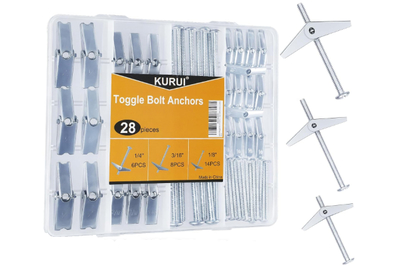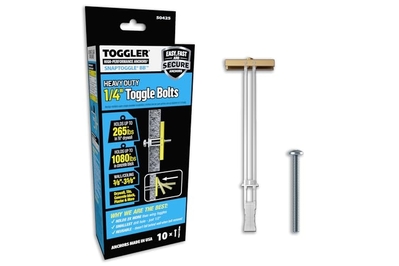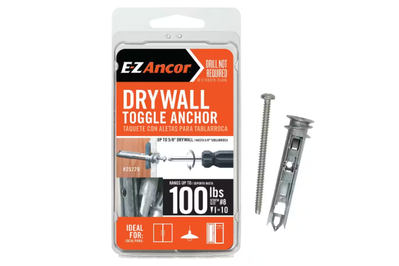This is an ode to the toggle bolt, an elegant and inexpensive fix for wobbly towel bars, not-so-floating shelves, and any other fixture that needs to hold some weight on a hollow wall. For less than $1 per bolt, I’ve purchased my freedom from wiggly wall mounts.
The loose towel bar in my bathroom was one of those nuisances that my family tolerated, even as it regularly drained our patience and made our lives a little bit worse. Anytime I heard someone washing their hands, I feared that this would be the hand-drying towel tug that would pull the bar out of the wall again, setting me up for yet another attempted repair.
Part of the issue: Towel bars are usually 24 inches long, but a typical American home’s wall (to the extent that such a thing exists) has a solid wood stud every 16 inches. One end of that bar won’t line up with a stud.
To make up for that, most towel bars come with a couple of plastic drywall plugs, meant to hold support screws steady in a hollow wall without the support of a stud (or blocking between the studs). But those thin plugs can support only a few pounds of weight. Even a wet bath towel puts too much stress on such a flimsy anchor, and if your kindergartener decides to use it like a monkey bar, forget it.
I had tried to secure the bar with increasingly thick plastic plugs and screws, and my daughter learned not to hang from it, but the bar eventually started dangling again anyway.
And then I heard about toggle bolts.
In the midst of my towel-bar struggles, the TikTok algorithm graced me with videos by a TV wall-mounting pro who kept talking about toggle bolts. If he couldn’t find a stud where he needed one, he would mount the TV bracket to the wall with a toggle bolt instead. He trusts them enough to hold a $3,000, 77-inch OLED, so I figured they’d be fine for a towel bar.

A toggle bolt slides through a small hole in your wall and then flicks or flips open inside. Once you tighten it down, the toggle grips the back of the surface it’s mounted to—drywall, lath, metal framing, even cinder blocks—so that the bolt is braced on both sides of the wall. That gives the bolt much more stability and strength than many other drywall anchors provide.
Inside the wall, the toggle pops or flips open. As you tighten it down, the wings (or post) grip the interior surface and help brace the bolt. This allows the assembly to carry much more weight than a thin, plastic drywall anchor. Liam McCabe/NYT Wirecutter
A small, ⅛-inch butterfly-style toggle can support 30 pounds per bolt, even in thin drywall. But you can find plenty of other sizes and styles, the beefiest of which are rated to hold more than 200 pounds in normal half-inch drywall. If you use multiple toggle bolts, the maximum weight goes even higher.
If you can find a stud, you should use it. Ben Seaman of Xpress TV Mounting in Houston—the TV-mounting pro from TikTok—told me that he’s usually comfortable mounting a TV with toggle bolts alone. But he always uses a wood stud if it’s in a convenient spot, and then he adds toggle bolts for extra support as needed.
That’s the approach I took with my towel bar: one end in the stud, the other end toggle-bolted into the drywall.
When I dry my hands now, all I feel is terry cloth. No wobbling, no worrying about how and when I’ll get around to fixing the bar when it inevitably comes loose. After six months, it’s still exactly where I installed it.
After fixing the towel bar, I started looking for more toggleable projects. The wire shelf in the tiny, sloped closet with the weird framing: toggled and solid as a rock. The toilet paper holder downstairs: wings deployed, jiggle-free.
The small mirror near the front door? That one was not toggleable, actually. The hole for the toggle is bigger than the head of the bolt that it’s attached to. Wall decor is generally light enough that it doesn’t need a mounting bracket, so without that hardware between the head of the bolt and the hole in the wall, the bolt falls right through. There’s a time and a place for everything, and in this case, a sturdy screw-in drywall anchor was a better choice.
A toggle bolt isn’t a surefire safe option for all heavy loads, either. Seaman told me that when he’s installing a full-motion TV mount, he always uses a stud or some kind of solid backing.
“The weight that comes off that wall, it’s a totally different kind of weight,” he said of the movable brackets. He compared it to a bicep curl: “If I told you to hold the dumbbell in the up position, you can hold that all day. But the second that you stick your arm out straight, it puts a lot more force on your shoulder.”
So if you’re installing something that needs to support a lot of weight under leverage, especially if it moves, think twice about relying on toggle bolts alone.
If you’re planning to start toggling, you’ll generally need a drill and some bits, though they’re not always necessary. You might also need some spackle, sandpaper, and paint to patch up any old holes—the same kit you’ll need to fill any hole in your wall. And be prepared to deal with some dust.
Toggle bolts come in a few varieties. Generic butterfly-style toggle bolts are cheap and hold plenty of weight, and I’ve been working my way through a box of 3/16-inch butterflies with 3-inch bolts. Even that has been overkill for some of my projects, though, and I think most people would be better off with a variety pack like this one, with a mix of butterflies and shorter, 2-inch bolts.
Seaman told me that he’ll use any toggle bolts but prefers a type called the Snaptoggle. They cost a little extra, but they’re rated to hold more weight than butterflies of a similar size. He says that he also finds the quality control to be better than for other types and brands.
Guest pick
I also experimented with a no-drill E-Z Ancor toggle bolt, which you can install with just a screwdriver. Buyer ratings are mixed, and this toggle bolt is the most expensive type I’ve seen, but I followed the directions closely, and it worked fine for me.
Staff pick
Plastic pop-open toggle bolts are available, too, but the metal ones are sturdier and really don’t cost much, so I’m hard-pressed to think of a project where plastic toggles are the better choice.
I also recommend buying a few more toggle bolts that you think you’ll need. I’ve dropped a few into the wall, where they will remain for decades until some demolition crew finds them. Maybe then I’ll finally figure out where all the studs are.
This article was edited by Megan Beauchamp and Maxine Builder.






